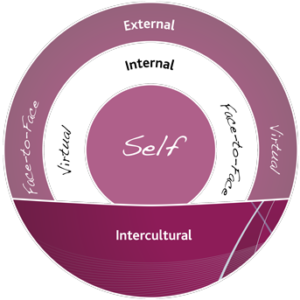Does mindfulness have anything to do in schools?
Lately, I have been teaching mindfulness in schools to educators and teachers; this nice article features my work and asks some interesting questions. Read more here!
Coach | Trainer | Speaker | Consultant
Does mindfulness have anything to do in schools?
Lately, I have been teaching mindfulness in schools to educators and teachers; this nice article features my work and asks some interesting questions. Read more here!
Communication is a skill that you can learn. It’s like riding a bicycle or typing. If you’re willing to work at it, you can rapidly improve the quality of every part of your life.” – Brian Tracy
You will appreciate that even though communication skills are so important to success in the workplace and everywhere else, many individuals continue to struggle with it, unable to communicate their thoughts and ideas effectively – whether in verbal, non-verbal or written format. They struggle to convey their thoughts and ideas in an accurate manner, making it difficult to move forward and nearly impossible to collaborate. Things even get more complicated when communication happens between actors of different cultures, backgrounds, ages and digital means of communication.
 Communication is like a “two-way street”. And, it involves not only two, but three components:
Communication is like a “two-way street”. And, it involves not only two, but three components:
We have to be HERE first if we’re going to communicate. Communication is a flow of understanding; presence helps to create a ground for connection, and provides an important tool for examining and re-training our communication patterns. Let’s just think about how often you communicate with people during your day: you write emails, facilitate meetings, participate in conference calls, create reports, devise presentations, debate with your colleagues… the list goes on!
Our intention when communicating, forms the basis of our orientation in any conversation. What we need to do is to understand our motivation: where are we coming from, what do we want to achieve while communicating? Without a clear and solid grounding and the intention to connect, to understand, we run the risk of using communication tools to simply repeat old habits of interacting. This foundation is a systematic training of our attention to notice four basic components of our experience, as taught in Nonviolent Communication:
Did you know that :
The single most powerful and transformative ingredient in dialogue is the intention to understand?
The good news is, effective and mindful communication is a skill that can be practiced! In fact, habits of speaking, listening, and relating are learned. We have all had “communication training” by our family, our culture, our society, and our life experiences. But:
When our needs aren’t met, we have been conditioned to see things in terms of blame.
Internal thoughts of blame however can provide useful information about what really matters to us! If we want someone to do something differently, to listen to or understand us, how useful of a strategy is it to blame them? Well, not that useful, right? So here’s what to do:
Up for a try? Thanks for reading and have a great week,
Jenny
 Have you ever noticed for example that when you are feeling “down” you sometimes simply have to engage in some stimulating breathing exercises or in doing something that nourishes you to feel much better? We tend to believe that all emotions last a long time but actually they don’t as it really depends which emotions we are talking about.
Have you ever noticed for example that when you are feeling “down” you sometimes simply have to engage in some stimulating breathing exercises or in doing something that nourishes you to feel much better? We tend to believe that all emotions last a long time but actually they don’t as it really depends which emotions we are talking about.
First, let us make the difference between “emotions” and “feelings”. In this article, the well-known neurologist Antonio R. Damasio, says the following:
“In everyday language we often use the terms interchangeably. This shows how closely connected emotions are with feelings. But for neuroscience, emotions are more or less the complex reactions the body has to certain stimuli. When we are afraid of something, our hearts begin to race, our mouths become dry, our skin turns pale and our muscles contract. This emotional reaction occurs automatically and unconsciously. Feelings occur after we become aware in our brain of such physical changes; only then do we experience the feeling of fear.”
Thus feelings are formed by emotions.
To test the length and effect of emotions, Philippe Verduyn and Saskia Lavrijsen from the University of Leuven in Belgium asked 233 students to recollect recent emotional episodes and report their duration.[1]. They found out that:
„Rumination is the central determinant of why some emotions last longer than others. Emotions associated with high levels of rumination will last longest“ (Professor Verduyn).”
Out of a set of 27 emotions, sadness apparently lasted the longest whereas shame, surprise, fear, disgust, boredom, being touched, irritated or feeling relief were over much faster.[2]
Mindfulness can help you notice what’s going on in your body, inviting uncomfortable emotions and feelings in and letting them go, exactly as with positive emotions and wanted feelings. Being with yourself moment by moment helps you to stay anchored and not being “knocked-down” as well as feeling “helpless” when encountering strong emotions.
The following cartoon of Charlie Brown illustrates this in a fantastic way and it always makes me smile when I look at it! I hope you do so too….
Jenny
[1] http://www.dailymail.co.uk/sciencetech/article-2815719/Feeling-sad-FIVE-DAYS-shift-mood-Sadness-lasts-240-times-longer-emotions-study-claims.html
[2] The full research can be found here : http://link.springer.com/article/10.1007/s11031-014-9445-y
Be the change that you wish to see in the world – Mahatma Gandhi
It is no coincidence that today’s post starts with this important quote; I have indeed spent the last months figuring out the organisational culture of an international association being confronted once again with entrenched positions, misunderstandings related to poor communication, a lack of intercultural dialogue and pretty much negative mindsets.
Looking at all this with my trained “mindful” eyes and as always believing in the power of motivation, empathy and a transparent, strategic, positive way forward, I have begun to slowly impact this environment by simply “walking the talk“, looking at solutions rather than problems and listening to the various actors and their concerns to identify an appropriate way forward.
Among others, I reminded people that:
The next mile stone on the road to a more mindful organisation is set: a creative vision finding workshop for staff and Board where unconscious wishes and thoughts will have a central role to play. Looking very much forward to seeing how people will react as this doesn’t follow the “usual” way to proceed!
Stay tuned for more insights from within,
Jenny
Usually, we all have many… to name only a few:
All of these roles require your attention, your energy and commitment; sometimes it is difficult to switch from one to the other and/or to combine some of them at the same time. You might feel stretched to your limits, having not enough time to rest and for yourself leading to becoming irritable and stressed. There might be moments of doubts: “Am I a good father or mother? Or “All other spouses are surely doing a better job than myself”.
Feeling overwhelmed yourself very often leads to less patience: with your children, partner and other people surrounding you and of course with yourself. You react upon triggers not being able to calmly approach problems and challenges.
Becoming familiar with and practicing mindfulness techniques is a skill that will help you deal with the stresses, uncertainty and complexity of life in the 21st century. By being more mindful yourself, you will also see that your relationships will change. They will unconsciously feel the change and respond to it with their own nervous system!
Of course you will still wear the same hats as you did before, but you will be able to remain yourself, non-judgmental and less prone to being hijacked by your own emotions, feelings and body sensations.
“We have more possibilities available in each moment than we realize.” – Thích Nhất Hạnh
One of the best ways I find for recovering my inner strength and recharging my batteries is being in the mountains. Living in Switzerland, I feel very lucky as I can quickly escape and in a couple of hours be in places of extreme beauty.
Last year, I published a nice post about mountains and especially the so-called “mountain-meditation” from Kabat-Zinn. Today, I found another guiding text that I want to share here with you now. It also comes from Kabat-Zinn and is adapted from “Mindfulness Meditation in Everyday Life“. Enjoy!
The mountain meditation
When it comes to meditation, mountains have a lot to teach us. The image of a the mountain held in the mind’s eye and in the body, can refresh our memory of why we are sitting, and of what it really means to dwell in the realm of non-doing.
Picture the most beautiful mountain you know – or can imagine. Notice its overall shape, the lofty peak, the base rooted in the rock of the earth’s crust, the sloping sides. Note how massive it is, how unmoving, how beautiful.
See if you can bring the mountain into your own body – your head becomes the lofty peak; your shoulders and arms the sides of the mountain; your buttocks and legs the solid base rooted to your cushion on the floor or to your chair.
Notice any emotions you are feeling and your mood as though they are the weather around the mountain. Is your weather right now sunny and calm or stormy with lashing rain, is it icy or warm? Allow your personal weather to be the way it is, noticing if it intensifies, changes or stays the same through the meditation.
Fully become the breathing mountain, unwavering in your stillness, completely what you are – beyond words and thought, a centred, rooted, unmoving presence.
As the light changes, as night follows day and day night, the mountain just sits, simply being itself. It remains still as the seasons flow into one another and as the weather changes moment by moment. Storms may come, but still the mountain sits.
Calmness abiding all change.
Did you know that being kind to yourself and to others has considerable consequences? Everybody knows that responding in a mindful, curious, open, non-judgmental and kind manner in situations of interpersonal communication is a key to effectively transmitting your message and generating a fruitful dialogue.
But what I am sure you did not know is that a Japanese researcher was actually able to demonstrate the effects of kind words versus mean words/insults in water crystals. During many years, Masuro Emoto took photographs of various water crystals. He then exposed them to words, pictures, emotions, even music that were either more of a positive or a negative nature. The shapes and forms of the water crystals positively influenced became even more beautiful; the ones receiving a negative treatment became ugly and even deformed.
There apparently is an experiment that you could try out at home to see this for yourself (I still have to do it):
Fill two small glasses with a little bit of cooked rice; add some water on top of the rice. On one of the glasses, put a label on which you would write the words you would typically use when insulting/being mean to somebody (for example: “You idiot”). On the other glass, you put a label writing a nice thought, kind and pleasant words. (For example: “You are beautiful”). Please chose your own words!
Now put the two glasses away from each other and every day, for the next three weeks you will now:
- Insult the glass with the “mean” label
- Very gently and kindly speak to the glass with the “kind” label.
Progressively you will perceive the effects: the glass with the “mean” label will begin to smell badly and even decompose (rot). The “kind” glass will release a pleasant odor, sometimes even somewhat sweet. The rice will still be white, whereas in the other glass the rice will become dark.
Please be sure to let me know what you found out!
At the heart of an interpersonal relationship lies the communication between individuals, be it at work or elsewhere.
Did you know that mindfulness can help us to become more directly aware of our own personal and immediate experience whilst communicating with somebody else? This is in fact an essential step before we can fully open to another and communicate effectively. The awareness of what happens within ourselves supports our ability to turn towards and be with whatever arises in this shared experience: in a mindful manner.
The intention here is not resolution or relief but knowledge of what the present moment experience is like. And even if the experience is difficult, you can actually learn to be with it in many creative ways.
The important thing is:
Mindful communication can be learned but definitely needs to be practiced!
 Mindfulness can not only enhance athletic, academic, or work performance; it also has a profound impact on stress resistance, resilience, emotional balance, team work, mental habits to only name a few. How does this happen? With guidance and practice you learn how to let go of disrupting thoughts to be able to increase your focus and physical awareness on what is really present for you at that very moment. You become very self aware in terms of what is going on in your body and mind and to respond rather than react to stressors, difficult situations, triggers etc.
Mindfulness can not only enhance athletic, academic, or work performance; it also has a profound impact on stress resistance, resilience, emotional balance, team work, mental habits to only name a few. How does this happen? With guidance and practice you learn how to let go of disrupting thoughts to be able to increase your focus and physical awareness on what is really present for you at that very moment. You become very self aware in terms of what is going on in your body and mind and to respond rather than react to stressors, difficult situations, triggers etc.
There are a multitude of examples where mindfulness has significantly improved athletic results as well as peak performance or even team cohesion and team performance.
The same skills practiced in your mindfulness training will then enhance your training and help you deal with injuries and other challenges, giving yourself a competitive edge. Additionally, the competences that you will have gained will also significantly impact your attitude and behaviour so that you can benefit from them in the classroom as well as in life off the court, field or track.
Susan Salzbrenner, author of “Play Abroad 101 – Your ultimate guide to success as an athlete abroad” has interviewed me in her podcast about mindfulness for athletes and its benefits. Click here to read more and listen in!
 Looking forward to your reactions! I accompany athletes, adults and children through individual coaching and training geared towards their particular needs in mindfulness. I also organise retreats and group courses.
Looking forward to your reactions! I accompany athletes, adults and children through individual coaching and training geared towards their particular needs in mindfulness. I also organise retreats and group courses.
Contact me to learn more!
 Just now, in October 2015, the Mindfulness All-Party Parliamentary Group (MAPPG) in the UK published a ground-breaking report, entitled “Mindful Nation UK”. In it, it states that: “Our long-term vision is of the UK as a group of mindful nations, an international pioneer of a National Mental Health Service which has, at its heart, a deep understanding of how best to support human flourishing and thereby the prosperity of the country. “ For this to happen, the report recommends governmental action in four particular sectors:
Just now, in October 2015, the Mindfulness All-Party Parliamentary Group (MAPPG) in the UK published a ground-breaking report, entitled “Mindful Nation UK”. In it, it states that: “Our long-term vision is of the UK as a group of mindful nations, an international pioneer of a National Mental Health Service which has, at its heart, a deep understanding of how best to support human flourishing and thereby the prosperity of the country. “ For this to happen, the report recommends governmental action in four particular sectors:
Having been in the Netherlands recently, I see the same trend forward; schools are training teachers in mindfulness as well as their pupils, trainers and consultants are proposing courses, workshops and interventions. I truly have never seen so many people familiar with and active in mindfulness.
I will definitely bring these great thoughts and projects back to French speaking Switzerland, where I currently live, to try and raise awareness and openness towards new and innovative methods that have proven their worth. Mindful Communication, Mindful Leadership and regular mindfulness courses for adults, teachers and children is what I have to offer. Contact me to learn more!
Jenny